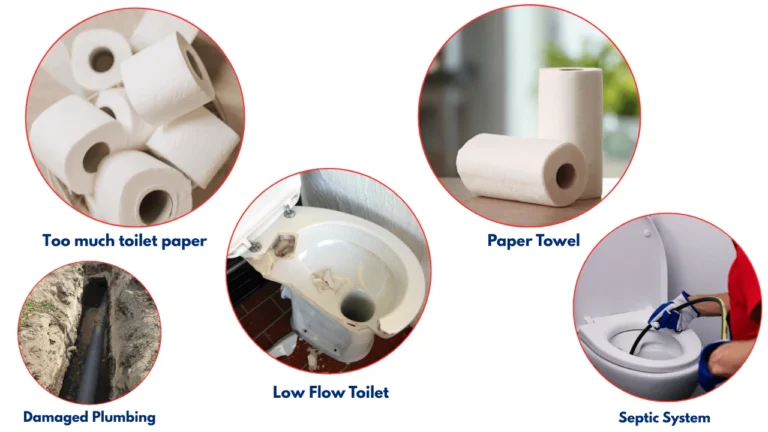FIVE-STAR TEAM WARRANTY &
SAME-DAY SERVICE
How to Unclog a Toilet Step by Step – 2025
There’s nothing quite as annoying as a toilet that just won’t cooperate especially when it keeps clogging over and over. Don’t worry, though! Most clogs can be fixed at home without calling a plumber (and without losing your sanity). In this guide, I’ll walk you step by step through unclogging your toilet safely in 2025. With years of plumbing experience under my belt, I’ll share practical tips, must-have tools, and simple tricks to keep your bathroom running smoothly and your mornings stress-free.
Why Toilets Keep Clogging

Before we jump into the steps, it’s helpful to understand why toilets clog in the first place. Here are the most common reasons:
Flushing Non-Flushable Items
Wipes (even “flushable” ones), paper towels, feminine hygiene products, and small toys can block your toilet.
Too Much Toilet Paper
Even regular toilet paper can cause clogs if used excessively in one flush.
Old or Damaged Plumbing
Pipes can become narrow, cracked, or misaligned over time, making clogs more likely.
Low-Flow Toilet Issues
Older low-flow toilets may struggle to create enough water pressure to push waste through the pipes.
Hard Water Buildup
Minerals in water can accumulate in your pipes, reducing flow and increasing the risk of clogs.
Septic System Problems
For homes on septic, a full or poorly maintained tank can cause toilets to back up.
Understanding these causes will help you prevent future clogs while effectively fixing the current problem.
Step 1: Gather Your Tools and Safety Gear
Before diving in, make sure you have the proper tools and safety gear. Here’s what you’ll need:
- Flange plunger: Designed for toilets; better than a standard cup plunger.
- Rubber gloves: Protect your hands from bacteria and spills.
- Bucket of water: Helps manage overflowing water or flush the toilet if needed.
- Toilet auger (plumbing snake): For stubborn clogs that a plunger can’t handle.
- Old towels or rags: Protect floors and make cleanup easier.
Pro Tip: Prepare everything in advance. Nothing is worse than running around looking for a plunger mid-clog.
Step 2: Assess the Clog
Before plunging, take a moment to evaluate the situation:
- Check the water level in the bowl. If it’s near overflowing, remove some water with a bucket to prevent spills.
- Determine the type of clog: Is it minor (plunger will fix) or stubborn (needs an auger)?
- Visual check: Look for foreign objects that might be causing the clog sometimes it’s obvious and easy to remove.
Fun Fact: Sometimes, small clogs are caused by habits like using too much toilet paper or flushing wipes that don’t dissolve.
Step 3: Plunge Like a Pro
Plunging seems simple, but doing it incorrectly won’t clear the clog. Here’s how to do it effectively:
- Insert the plunger so the flange fits snugly into the drain hole.
- Push down slowly, then pull up sharply repeat 10–15 times.
- Flush gently to see if the water drains properly.
Common Mistakes:
- Using a flat cup plunger instead of a flange plunger.
- Not creating a tight seal air escapes instead of creating suction.
- Giving up too early; it can take multiple plunges to move the clog.
Step 4: Use a Toilet Auger for Stubborn Clogs
If plunging doesn’t work, it’s time for the toilet auger:
- Insert the auger cable into the toilet drain.
- Turn the handle clockwise until you feel resistance.
- Gently push through the clog and pull the auger back.
- Flush to confirm the blockage is gone.
Pro Tips:
- Avoid forcing the auger too hard; this can scratch or crack your toilet.
- Use slow, steady motions to break up or hook the clog.
Step 5: Clean Up and Disinfect
After the clog is cleared:
- Remove any water spills with towels.
- Disinfect the toilet, plunger, auger, and surrounding areas.
- Wash your hands thoroughly even if you wore gloves.
Step 6: Prevent Future Clogs
Prevention is the best way to avoid repeating this stressful experience:
- Only flush toilet paper no wipes, paper towels, or other objects.
- Use moderate amounts of toilet paper per flush.
- Schedule occasional plumbing inspections to detect pipe damage or buildup.
- Upgrade old toilets that struggle with flushing.
- Educate household members (especially kids) on proper flushing habits.
- Consider small maintenance tricks, like monthly vinegar + baking soda flushes to keep pipes clean.
Common Mistakes That Make Clogs Worse
- Chemical drain cleaners: They can damage your pipes and make clogs worse.
- Over-plunging aggressively: Can splash water and damage fixtures.
- Ignoring repeated clogs: Could indicate a deeper issue, like a main sewer line problem.
Signs You Need a Professional Plumber

Sometimes, even with the best DIY techniques, a clog won’t budge. Call a professional if you notice:
- Multiple toilets or drains backing up at once.
- Persistent foul odors coming from your toilet or drains.
- Water backing up into showers, tubs, or sinks.
- Repeated clogs that occur within days or weeks of being cleared.
Post views: 26
Frequently Asked Questions (FAQs)
Q1: Can I use chemical drain cleaners for my toilet?
A1: It’s not recommended. Chemicals can erode pipes, worsen clogs, and harm the environment.
Q2: How do I know if the clog is in the toilet or the main sewer line?
A2: If multiple toilets or drains are slow or backing up, the issue is likely in the main sewer line.
Q3: How often should I maintain my toilet to prevent clogs?
A3: Inspect plumbing periodically and educate household members on proper flushing. Occasional preventative flushes with baking soda and vinegar help, too.
Q4: Can low water pressure cause clogs?
A4: Yes! Toilets with low water pressure might not flush waste completely, increasing the risk of clogs.
Latest posts

Gas vs. Electric Water Heater: Which Is Better for Your Home in 2025?
Choosing between a gas vs electric water heater is one of the most important decisions a homeowner can make in 2025....

Furnace Not Turning On? 7 Things to Check Before Calling a Technician
When your furnace won’t turn on, it’s stressful. The house is getting colder, everyone’s complaining, and you’re...


If you still have questions or need advice, please leave a request and we will contact you as soon as possible
Need a plumber and got no clue where to start?
(408) 539-6936Facing a plumbing issue? Get a FREE in-person estimate and quick solutions from our skilled technicians, ensuring your home runs smoothly again!
